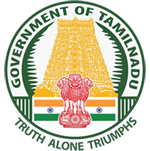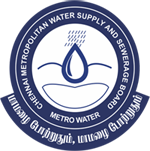



Chennai Metropolitan Water Supply and Sewerage Board
Sewerage System
1. In early 1890, surface drains in the City were connected to Pumping Stations and the wastewater conveyed for disposal away from inhabitation. The proposal for comprehensive drainage scheme to cater to the needs of a topographically flat, fast growing city was formulated in 1907 and works were initiated in 1910 and completed during 1914 in stages. The systems were designed for the population of 6.5 lakhs expected in 1961 at 114 lit. per capita per day of water supply. The system originally consisted of a network of force mains and brick gravity sewers served by 3 Pumping Stations at Royapuram, Purasaiwalkam and Napier Park and ultimately discharging wastewater into the sea at Kasimedu on the Northeastern boundary of the City.
2. A fundamental change to this system was made in 1956 by laying a force main to divert part of the sewage discharged from the Purasaiwalkam Pumping Station to Kodungaiyur where the sewage farm was started. Thereafter a comprehensive wastewater management scheme was formulated. The implementation of these schemes commenced in 1961 and had undergone modifications periodically commensurate with the system requirements of an expanding City and the growing population. The wastewater system for the City has been divided into five drainage zones. These zones of macro systems covering the entire City had independent zonal collections, conveyance, treatment and disposal facilities.
- Zone–I of sewerage system forms the oldest part of the City and is in the North eastern portion of the City bounded by Bay of Bengal to the East, the City limits to the North, the Buckingham Canal to the West and Pycrafts Road to the South. It covers the areas of Tondaiarpet, Washermenpet, Royapuram, George Town, Chindadripet etc. The sewage collected from this Zone–I is drained to the treatment plant located at Kodungaiyur (Zone–I Plant) which was commissioned in 1991 for the capacity of 80 MLD.
- Zone–II is the largest of the five macro systems and serves the Central and Northern portions of the City. It is bounded by the Buckingham Canal in the East and the Corporation limits in the North. The area served are Nungambakkam, Chetpet, Kilpauk, Egmore, Purasaiwalkam, Ayanavaram, Perambur, Vyasarpadi, Sembium, Kolathur, Periyar Nagar, Jawahar Nagar and Kodungaiyur etc. The wastewater generated in this Zones is drained into the treatment plant at Kodungaiyur (Zone–II Plant) which was commissioned in the year 1989 for the capacity of 80 MLD.
- Zone–III lies between Zone–II and Zone–IV to the West. It comprises Thyagaraya Nagar, Kodambakkam, Arumbakkam, Anna Nagar and Koyambedu. The wastewater generated in this Zone is conveyed to the treatment plant at Koyambedu (Zone–III Plant), which was commissioned in the year 1978 for the capacity of 34 MLD.
- Zone–IV is the smallest of the macro systems lying to the Southwest of the City. The areas covered are Ashok Nagar, Saidapet, Jafferkhanpet, K.K. Nagar and Nesapakkam. The wastewater generated in this Zone is conveyed to the treatment plant at Nesapakkam (Zone–IV Plant) which was commissioned in the year 1974 for the capacity of 23 MLD.
- Zone–V is the second largest of the five macro systems and is to the South of the City which is bifurcated by the Adyar River. Areas covered are Ice House, Mylapore, Adyar, Guindy, Velacherry, Gandhi Nagar, Indra Nagar etc. The wastewater collected in this Zone is conveyed to the treatment plant at Perungudi (Zone–V Plant) which was commissioned for primary treatment only in the year 1980 for the capacity of 45 MLD.
3. The Master Plan for Wastewater Management (Sewerage) was formulated in 1978 to serve the population expected in 2008. Extension of sewer systems to the newly developed Areas and improvements to the existing system were carried out based on this Master Plan. During 1989–1991 proposals were formulated for short term and long term improvements to the sewerage interceptor system, sewage pumping stations, pumping mains and sewage treatment plants. The works were carried out in stages for improvement to the collection system, pumping stations and sewage treatment plants. At Villivakkam, a small treatment plant of 5 MLD capacity developed by the Housing Board for SIDCO Nagar of Villivakkam was taken over by C.M.W.S.S. Board during 1984 and now abondoned. The flow received at Villivakkam relay pumping station is being conveyed to Kudungaiyur STP.
4. The Master Plan was updated in 1991 to cater to the needs of population expected in 2021 and the proposal envisages improvement to (a) sewage collection and conveyance system in the City which includes strengthening of the existing collection system for all zones, strengthening the existing conveyance system including force main, improvement to critical sewage pumping stations, provision of collection and conveyance system for un-sewered areas, (b) the sewage treatment and disposal facilities. The works were executed in stages according to the priority by mobilising funds in-house by Metrowater.
5. The Detailed design and Engineering for sewage collection & conveyance and for the sewage treatment & disposal were finalised through independent consultants during 1995–1998 for expanding the capacity of sewage collection, conveyance system and treatment & disposal arrangements to meet the requirement for the population expected in 2021 and due to increase in the availability of water under Krishna Water Supply Scheme. The total estimated cost of the proposal was about Rs.1,300.00 crore. Based on this detailed design and engineering, project proposals were formulated for implementation under Chennai City River Conservation Project in the year 2000 at the estimated cost of Rs.720.00 crore as first phase for 2011 sewage flow. The proposal consists of laying of interceptors 59.2 km. improvements to 28 nos. of pumping stations, construction of 3 nos. of new pumping stations and laying of sewage pumping mains 28.85 km. gravity conveying main 17.3 km. and expansion of sewage treatment capacity for 264 MLD (Kodungaiyur - 110 MLD, Koyambedu 60 MLD,Nesapakkam - 40 MLD and Perungudi 54 MLD). These works were commenced in January 2001 and completed in August 2006.
6. The detailed design and Engineering for sewage treatment & disposal were finalized during 2007-2008 for sewage treatment & disposal arrangements to the requirement for the population expected in 2023 and due to increase in the availability of water under Veernam water supply scheme and Desalination water supply scheme. This detailed design and engineering, project proposals were formulated for implementation under Jawaharlal Nehru National Urban Renewal Mission (JNNURM). The proposal consists of 3 STPs viz 54 MLD STP at Nesapakkam (Zone-IV), 60 MLD STP at Perungudi (Zone-V) and 120 MLD STP at Koyambedu (Zone-III) expansion of sewage treatment capacity for 234 MLD. These works were commenced in February-2009 and completed in June-2015.
7. The Central Pollution Control Board (CPCB)/Tamil Nadu Pollution Control Board (TNPCB) had prescribed revised discharge Norms for discharging secondary treated effluent from Sewage Treatment plants vide MoEF (Ministry of Environment and Forest) notification dated. 24.11.2015 as follows
| S.No | Parameters | Raw Sewage quality | Treated Effluent Quality | |
| Existing Norms | Revised Norms | |||
| 1 | Biochemical Oxygen demand | 350 | ≤ 20 | < 10 |
| 2 | Total Suspended Solids | 450 | ≤ 30 | < 10 |
| 3 | Chemical Oxygen Demand | 700 | ≤ 250 | < 50 |
| 4 | pH | 5.5-9 | 5.5-9 | 6.5-9 |
| 5 | Ammonia Nitrogen (NH4-N) | - | - | < 5 |
| 6 | Total Nitrogen (N –Total) | - | - | < 10 |
| 7 | Phosphorous (Po4-P) | - | - | < 2 |
| 7 | Feacal coliform | - | < 1000 | < 100 |
8. In order to achieve the revised norms, Chennai Metropolitan Water Supply and Sewerage Board (CMWSSB) has prepared an proposal for “Improvement works including Modifications / Rehabilitation works to be carried out to achieve new disposal standards as prescribed by CPCB / TNPCB Norms in all the existing Sewage Treatment Plants at Kodungaiyur, Koyambedu, Nesapakkam, Perungudi and Alandur, Chennai City”. The TNIPP – II funds were sought for the above and the funds were sanctioned vide G.O (Ms) No.98 MA & WS (MW) Department, dated.19.09.2017 for an amount of Rs.226.00 Crores.
9. CMWSSB had to revise the proposal based on the recommendation made by consultant (M/s Shah Technical Consultant Pvt. ltd.,) and the proposal was revised as construction of New STPs - 2 Nos of 120MLD at Kodungaiyur, 50MLD at Nesapakkam, 60MLD at Perungudi and Improvements/Modification to existing STPs - 110MLD at Kodungaiyur, 120MLD & 60MLD at Koyambedu, 54MLD & 40MLD at Nesapakkam and 54MLD & 60MLD at Perungudi” for an estimate cost of Rs.811.40 Crores.
The capacity enhancement of the sewage treatment plant in Chennai city considering 2035 population projection has been proposed as follows
| 1. Kodungaiyur Zone I | 120 MLD |
| 2. Kodungaiyur Zone II | 120 MLD |
| 3. Nesapakkam | 50 MLD |
| 4. Perungudi | 60 MLD |
| Total | 350 MLD |
The construction works for these plants are under progress, the works are expected to be completed by end of 2022.
11. Improvement works including Modifications / Rehabilitation works to be carried out to achieve new disposal standards as prescribed by CPCB / TNPCB Norms in all the existing Sewage Treatment Plants at 110MLD plant at Kodungaiyur, 60MLD & 120MLD at Koyambedu, 40MLD & 54MLD at Nesapakkam,54MLD & 60MLD atPerungudi, Chennai Cityare under progress, the works are expected to be completed by mid of 2023.
| S.No | Name of Sewage Treatment Plant | Year of Commissioning | Treatment Capacity (in MLD) |
| 1 | Kodungaiyur - Zone I | 1991 | 80 |
| 2 | Kodungaiyur - Zone II | 1989 | 80 |
| 3 | Kodungaiyur - Zone I & II | 1989 | 110 |
| 4. | Koyambedu - Zone III | 1978 | 34 |
| 5. | Koyambedu - Zone III | 2005 | 60 |
| 6. | Koyambedu - Zone III | 2015 | 120 |
| 7. | Nesapakkam - Zone IV | 1974 | 23 |
| 8. | Nesapakkam - Zone IV | 2006 | 40 |
| 9. | Nesapakkam - Zone IV | 2014 | 54 |
| 10. | Perungudi - Zone V | 2006 | 54 |
| 11. | Perungudi - Zone V | 2012 | 60 |
| 12. | Alandur - Zone V | 2003 | 12 |
| 13. | Sholinganallur | 18 | |
| Total | 745 |
The present capacity of the treatment plant is 745 MLD.
In the sewage treatment process, bio-gas is produced and is being used to produce power to run the plants. This incidentally reduces the discharge of Green House Gas into the atmosphere and provides for Carbon Trading. CMWSS Board has adopted Clean Development Mechanism (CDM) which leads to savings in energy cost to a turn of Rs.45.46 lakhs per month.
The growth in the sewerage services compared to 1978 when the C.M.W.S.S. Board was formed till March 2022 are as below:
| Details | 1978 | March 2022 |
| Area covered | 74% | 82% |
| Total sewer Consumer | 1,14,000 | 9,30,531 |
| Length of sewer mains | 1,223 km. | 4,093 km. |
| No. of pumping stations | 58 | 302 |
| Treatment Plants | 3 nos. | 13 nos. |
| Treatment capacity | 57 MLD | 745 MLD |